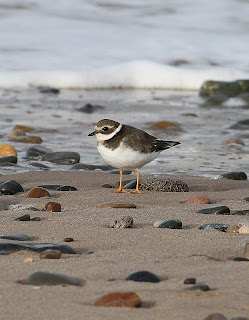


I counted the Lapwings at 30, so give and take a few non-breeders I estimate 10 pairs at the moment, some on eggs some not. The Peregrine also disturbed a dozen or so Redshank and similar numbers of Oystercatcher, and lesser number of Skylark. The raptor flew back to the marsh and everything settled down so I drove on up to Ridge Farm.
Although it was fine this morning, unlike the afternoon rain as I type, there was a cold south easterly wind which similar to many mornings lately didn’t bode too well. I did the track/sea wall circuit without seeing or hearing an awful lot except for a Sparrowhawk as soon as I jumped from the car then soon after Meadow Pipits, which I counted at 30+ coming from the west and northwest, some grounding as they arrived, others continuing on with a few “albas” also overhead. The customary 4 Skylarks sang and on the fields just inland I saw the now regular pairs of Lapwing and Oystercatcher. The wind began to pick up to a steady 10 to 12 mph.
I motored back through the wood where on the other side I spied a Barn Owl coming towards the car but it veered off over the hedge on seeing me. The local Tree Sparrows “chip chipped” and told me the owl was still there out of my sight. This owl isn’t very accommodating; I have seen it along here on several occasions lately but it never perches up for a portrait. But it won’t be long before they can’t run away.

A walk up to Pilling Water revealed more Meadow Pipits on the move as they came from the west along the wall and continued in the direction of Lane Ends; I counted 32 heading east, with little parties grounded here and there, together with 3 or 4 more albas but no Wheatears again this morning. When it finally warms up there will be a rush of Wheatears for sure.

The Goldeneye and Little Grebe pairs are still present on the Lane Ends pools, as are the Reed Buntings, 4 Little Egrets and 8 Teal across the road. I was watching some Pink-footed Geese flighting out on the marsh when a plane disturbed them. They whiffled in to land just in front of the other Peregrine sat on the edge of the green, the bigger pale Peregrine that through a distant binoculars view looks pure white. It sat there outlasting my impatience for something to happen, but with three hours to high tide I suppose it could wait for a while and a guaranteed meal.
The wind picked up more, it grew cloudier and I packed up for the day.











































.jpeg)




.jpg)













